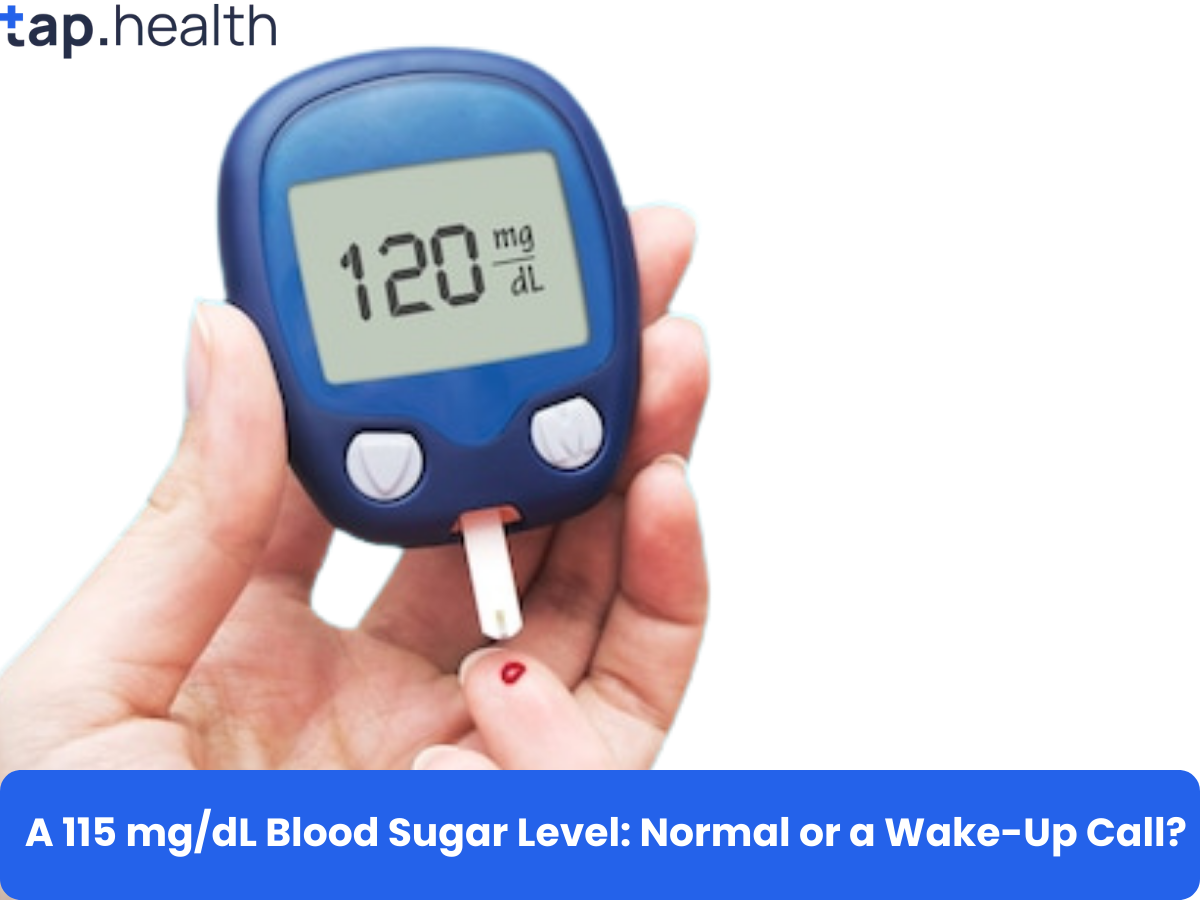Blood sugar, or blood glucose, is an essential part of our health. If you’ve checked your blood sugar and it reads 115 mg/dL, you might be wondering whether this is normal or if it’s something to be concerned about. In this blog post, we will explain what a 115 mg/dL blood sugar level means, whether it is considered normal or not, and how you can manage your blood sugar to stay healthy.
We’ll break it down using simple, easy-to-understand language, and give you tips on how to keep your blood sugar levels within a healthy range. Let’s dive in!
What is Blood Sugar?
Blood sugar, or blood glucose, is the amount of glucose (a type of sugar) that circulates in your blood. Glucose comes from the food you eat, especially carbohydrates, and is the main source of energy for your body’s cells. The hormone insulin, which is produced by the pancreas, helps regulate blood glucose by allowing it to enter your cells for energy or storage.
A healthy level of blood sugar is important for overall body function. Too much blood sugar (hyperglycemia) or too little (hypoglycemia) can lead to health problems. For this reason, it’s essential to monitor and maintain balanced blood sugar levels.
Understanding Blood Sugar Levels
Blood sugar levels are typically measured in milligrams per deciliter (mg/dL). They can vary depending on the time of day, the last time you ate, your physical activity, and your overall health. There are two main types of blood sugar measurements:
- Fasting blood sugar: This is measured after you haven’t eaten for at least 8 hours (usually in the morning).
- Postprandial blood sugar: This is measured after eating, typically two hours after a meal.
Here’s a breakdown of what different blood sugar readings mean:
- Normal fasting blood sugar: 70-99 mg/dL
- Prediabetes (Impaired Fasting Glucose): 100-125 mg/dL
- Diabetes: 126 mg/dL or higher (on two separate tests)
For postprandial blood sugar, a healthy reading should generally be less than 140 mg/dL.
What Does 115 mg/dL Mean?
If your fasting blood sugar is 115 mg/dL, this would fall into the prediabetes category. This means that your blood sugar levels are higher than normal but not yet high enough to be classified as diabetes. While not immediately dangerous, prediabetes is a warning sign that you need to take action to prevent your blood sugar from rising further.
Is an 115 mg/dL Sugar Level Normal?
In terms of post-meal readings, a 115 mg/dL is considered normal, as it falls below the 140 mg/dL threshold for diabetes. However, it’s still important to monitor your levels regularly, as repeated post-meal highs could indicate a need for lifestyle adjustments.
Factors That Affect Blood Sugar Levels
Many factors influence how your body regulates blood sugar. Understanding these can help you maintain healthy levels and take action if necessary.
1. Diet
What you eat has a direct impact on your blood sugar levels. Foods high in refined sugars and carbohydrates cause your blood glucose to rise quickly. In contrast, foods high in fiber, protein, and healthy fats help regulate blood sugar by slowing down the absorption of glucose.
2. Physical Activity
Exercise helps your body use insulin more efficiently and allows muscle cells to absorb glucose from the bloodstream, helping to lower blood sugar levels. Both aerobic activities (like walking, running, or cycling) and strength training exercises are beneficial.
3. Stress
Stress can increase blood sugar levels due to the release of stress hormones like cortisol and adrenaline, which cause the liver to release glucose into the blood. Learning to manage stress through relaxation techniques, such as deep breathing or meditation, can help stabilize blood sugar.
4. Sleep
Lack of sleep or poor-quality sleep can increase insulin resistance, making it harder for your body to regulate blood glucose effectively. Getting 7-9 hours of quality sleep each night is important for maintaining healthy blood sugar levels.
5. Medications
Some medications, including steroids, diuretics, and certain antidepressants, can raise blood sugar levels. If you’re on any medication, be sure to discuss its potential impact on your blood sugar with your doctor.
Why Should You Care About Your Blood Sugar?
Your blood sugar levels are a reflection of how well your body is managing glucose. High blood sugar levels over time can lead to serious health issues, especially when left untreated.
Risks of High Blood Sugar (Hyperglycemia):
If your blood sugar is consistently high, it can lead to complications like:
- Type 2 diabetes: A condition where your body becomes resistant to insulin and is unable to regulate blood glucose properly.
- Heart disease: High blood sugar can damage blood vessels, increasing the risk of cardiovascular problems.
- Kidney damage: Prolonged high blood sugar can harm your kidneys, potentially leading to kidney failure.
- Nerve damage: Hyperglycemia can cause neuropathy, leading to numbness or pain, particularly in the hands and feet.
- Eye damage: High blood sugar can damage blood vessels in the eyes, leading to conditions like diabetic retinopathy, which can cause vision problems.
Risks of Low Blood Sugar (Hypoglycemia):
If your blood sugar drops too low (below 70 mg/dL), it can cause:
- Fatigue
- Dizziness
- Confusion
- Severe hypoglycemia can lead to seizures and loss of consciousness
For these reasons, keeping your blood sugar levels within the healthy range is crucial for your well-being.
How to Maintain Healthy Blood Sugar Levels
If your blood sugar level is 115 mg/dL, it’s a good idea to take steps to lower it and prevent it from rising further. Here are some lifestyle changes you can make to help maintain balanced blood glucose:
1. Eat a Balanced Diet
Focus on a balanced, nutritious diet:
- Complex carbohydrates: Choose whole grains, fruits, and vegetables instead of refined carbs.
- High-fiber foods: Include plenty of vegetables, legumes, and whole grains to help stabilize blood sugar.
- Lean protein: Incorporate lean meats, fish, tofu, and beans to provide sustained energy.
- Healthy fats: Opt for healthy fats like avocados, nuts, and olive oil, which help control blood sugar levels.
2. Exercise Regularly
Aim for at least 150 minutes of moderate-intensity aerobic exercise per week (like walking or cycling). Strength training is also beneficial, as it builds muscle, which improves glucose uptake and helps regulate blood sugar.
3. Manage Stress
Chronic stress can increase blood sugar levels, so finding ways to manage stress is important. Activities like meditation, yoga, deep breathing exercises, and spending time in nature can help reduce stress.
4. Get Enough Sleep
Aim for 7-9 hours of sleep each night. Poor sleep increases insulin resistance, making it harder for your body to regulate glucose.
5. Monitor Your Blood Sugar
If you’re concerned about your blood sugar, regular monitoring is key. Using a glucose meter to test your blood sugar at different times of the day will help you track changes and see how your lifestyle choices are affecting your glucose levels.
What to Do If Your Blood Sugar is High
If your blood sugar is consistently above normal, it’s important to take action. Here are some steps you can take to lower your blood sugar levels:
- Increase physical activity: Regular exercise helps reduce blood sugar levels by improving insulin sensitivity.
- Cut down on sugary foods: Reduce your intake of refined sugars and carbohydrates, which can spike blood sugar.
- Stay hydrated: Drinking plenty of water helps flush excess glucose out of your bloodstream.
- Follow your doctor’s advice: If your blood sugar levels are high and persistent, consult with your healthcare provider for personalized treatment.
When to Seek Medical Advice
If your blood sugar is consistently above the normal range (for example, consistently 115 mg/dL or higher), it’s important to consult with a healthcare provider. You may be diagnosed with prediabetes, and your doctor can recommend lifestyle changes or medications to help regulate your blood sugar and reduce the risk of developing type 2 diabetes.
If you experience symptoms like increased thirst, frequent urination, fatigue, or blurred vision, these could be signs that your blood sugar is too high, and you should seek medical advice immediately.
Frequently Asked Questions (FAQs) on Is an 115 mg/dL Sugar Level Normal?
1. Is a 115 mg/dL blood sugar level normal?
A 115 mg/dL blood sugar level is considered prediabetes if it’s a fasting measurement. It’s not immediately dangerous but indicates that you need to take steps to prevent your blood sugar from rising further.
2. How can I lower my blood sugar from 115 mg/dL?
You can lower your blood sugar by adopting a healthier diet, exercising regularly, managing stress, and monitoring your blood sugar levels.
3. Should I worry if my blood sugar is consistently 115 mg/dL?
If your blood sugar is consistently 115 mg/dL, it is a sign of prediabetes, and you should consult a healthcare provider. Early intervention can help prevent the development of type 2 diabetes.
4. What are the symptoms of high blood sugar?
Symptoms of high blood sugar may include increased thirst, frequent urination, fatigue, and blurred vision. If you experience any of these, it’s important to consult a healthcare provider.
5. Can stress raise my blood sugar levels?
Yes, stress can cause an increase in blood sugar levels by releasing stress hormones like cortisol. Learning to manage stress is important for maintaining healthy blood glucose.
Conclusion
A blood sugar level of 115 mg/dL falls into the prediabetes category, which means your glucose levels are higher than normal but not yet high enough for a diabetes diagnosis. While not immediately dangerous, it is a clear sign that lifestyle changes are necessary to prevent the progression to type 2 diabetes.
By eating a balanced diet, exercising regularly, managing stress, and getting enough sleep, you can help lower your blood sugar levels and maintain good health. If your blood sugar is consistently high, it’s important to consult with a healthcare provider for guidance and support.
References
- Mayo Clinic. (2023). Prediabetes: Overview. Retrieved from https://www.mayoclinic.org/diseases-conditions/prediabetes/symptoms-causes/syc-20355278



